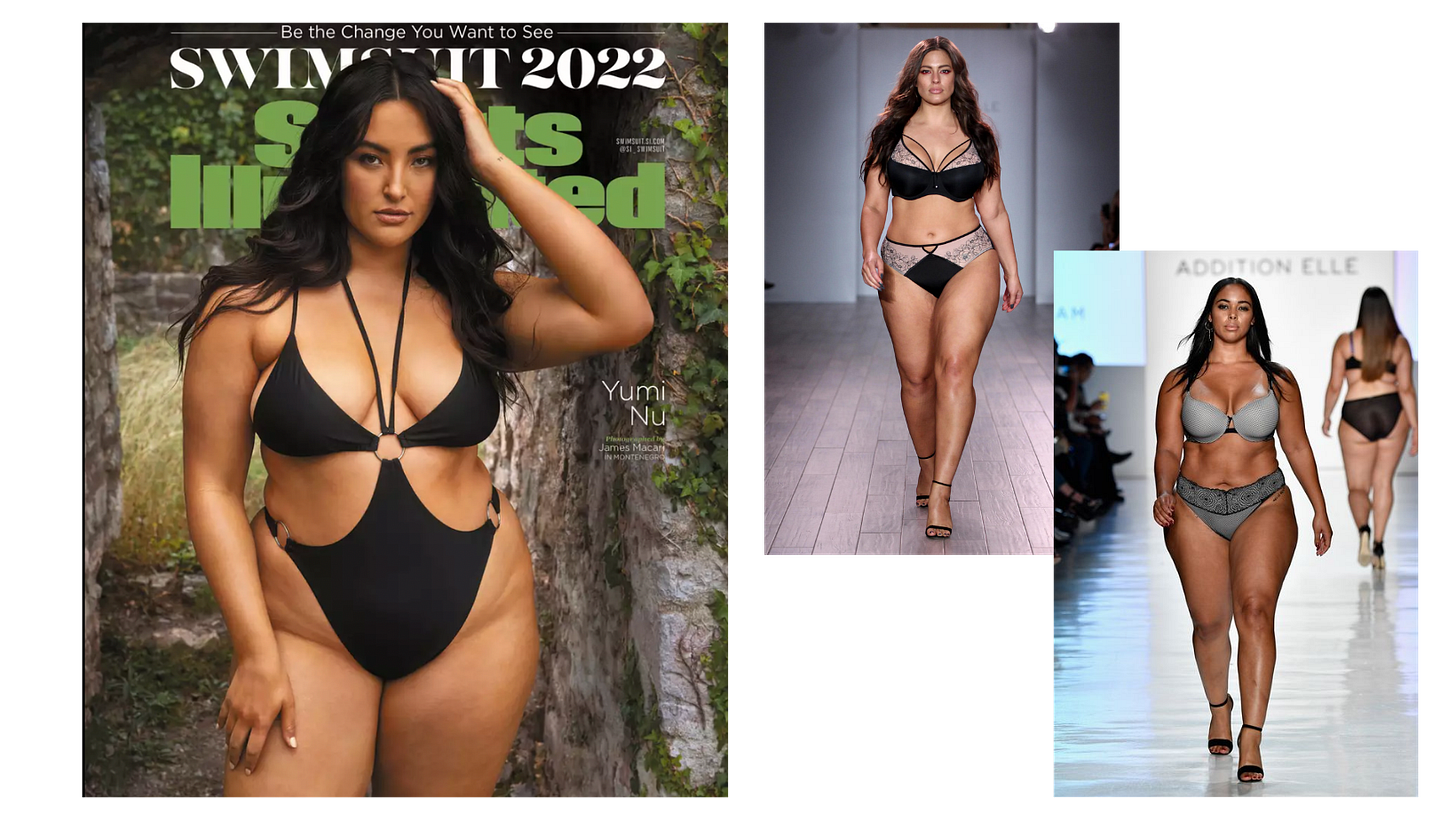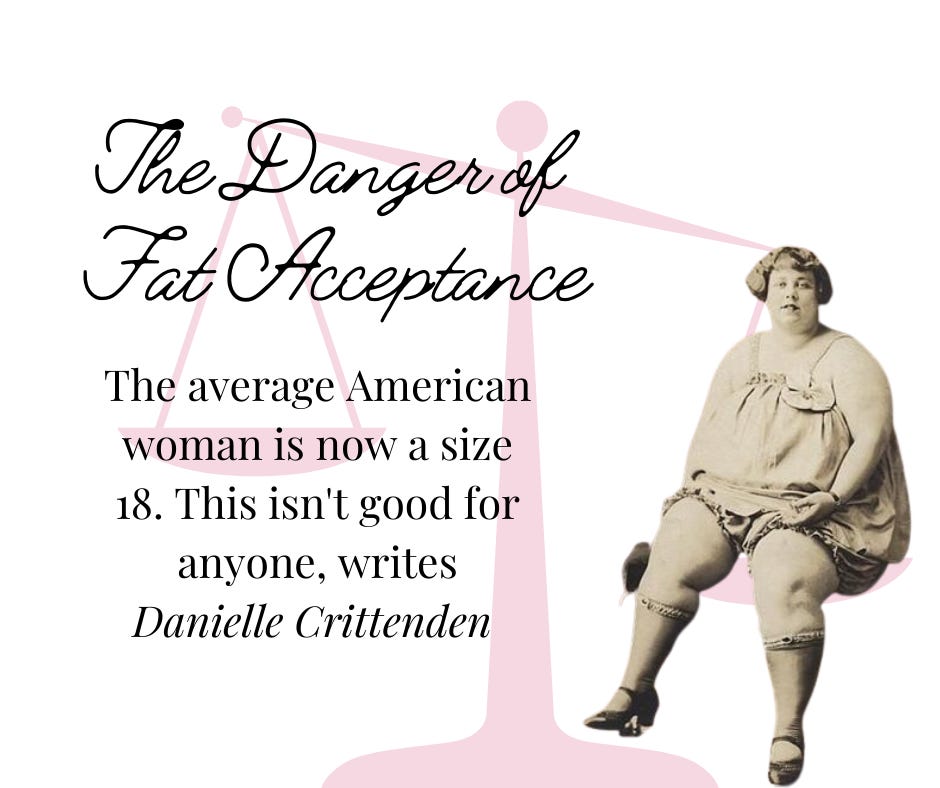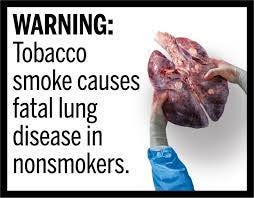The Danger of Fat Acceptance
The Average American Woman Is Now a Size 18
June 2022
I’M NOT TRYING to shame anyone here, but just think about that size. It’s up from a size 14 as recently as five years ago. It translates into a 46-inch bust and a 40-inch waist. An average weight would be 180 to 220 pounds depending on height. It’s a size that until very recently didn’t even exist on most clothing racks.
Since 1988, the average female waist circumference has increased 2.6 inches. A decade ago, sizes upwards of 14 were so rare that you could only find them at specialty stores. Morbid obesity was then so unusual it would sometimes make the news. In 1996, for example, there were headlines about a 1,000 pound New York man who needed to go to the hospital for a heart problem. The only way the EMT workers could get him out of his apartment was by hacking a 10-by-5 foot hole in the wall. He was then “carried through the hole on a stretcher used to move small whales…and transferred to an ambulance by forklift.”
A 2018 study published in Nature magazine observed:
In the United States, where adult obesity prevalence rates have been rising since the 1970s…about two-thirds of adults are now overweight and over 100,000 U.S. deaths per year are attributed to obesity. With obesity rates having tripled in many U.S. states over the past 25 years, this rise in obesity prevalence has accelerated. In 1990, about 11% of a typical U.S. state population was obese and no state had more than 15% obesity in its adult population. By 2015, U.S. obesity rates had more than doubled, with several states above 35% adult obesity and no state below 20% obesity in the population (Centers for Disease Control and Prevention, 2017). In one generation, the change has been so dramatic that the obesity rate in any U.S. state in 2015 would have been an extreme outlier in the U.S. in 1990.
As the nation has grown plumper, so has its acceptance of what once would have been considered dangerously high levels of obesity among women and men. Instead of treating this as a national health crisis, however, like the opioid epidemic or smoking, we’re supposed to pretend it’s not a problem at all, at least when it comes to women’s figures. Actually, we’re supposed to pretend more than that: Obesity is now in the eye of the beholder. It’s prejudiced — on par with racist — to suggest someone is “fat” or that “fat is bad.” And with women (although interestingly not with men), plus-sized models are setting new standards of beauty, to be admired and celebrated.

It’s inevitable that a fashion pendulum that swings so far one way will ultimately swing in the other (think from Jane Russell in the 1950s to Twiggy in the 1960s). The “heroin chic” of the 1990s and the anorexic Size 000s of the past few decades promoted figures and lifestyles that were no healthier than the current, heavy-set trend. The latter at least is certainly a more realistic portrayal of average women’s bodies (although to have a sculpted abdomen AND the waist and thighs of the models in some of the above photos requires surgical intervention. So, not entirely realistic.
Of course we all want women to feel “comfortable in their bodies.” No one should be subject to ridicule or teasing because of her weight. But it’s one thing to be compassionate, quite another to glamorize what amounts to a dangerous health epidemic. In many ways, the current campaign to endorse female heaviness reminds me of the old smoking advertisements. Even as evidence accumulated that smoking could cause cancer and other diseases, tobacco companies continued to push their products as tickets to coolness, sophistication, and even a great way to get sex. Then, as now, they were not beneath marketing to children. They dismissed potential harmful side effects - and continue to do so, as we saw recently with the debate over flavored e-cigarettes: Vaping! It’s Healthier Than Smoking!
What is especially disingenuous about the Fat Acceptance movement is that, all too typically, it will most adversely effect the most disadvantaged and least educated segments of the population. We live in a strange time, an unprecedented time, in which the wealthiest and most educated members of our society are fitter and healthier than the poorest.
According to a 2015 National Institutes of Health study of childhood obesity, for example, socioeconomic status powerfully predicts whether a child will be overweight.
Previous studies have shown race/ethnicity, particularly African American and/or Hispanic status, to be a predictor of overweight/obese status in children. However, these studies have failed to adjust for low socioeconomic status (SES).
For every 1% increase in low-income, there was a 1.17% increase in overweight/obese status. This pattern was observed across all African American and Hispanic rates in the communities studied.
And it’s a phenomenon that seems only to affect the richest and most advanced nations as well. As Nature noted,
One thing that is clear in high-income countries is that, despite decades of economic growth, obesity disproportionately affects the poor—the “poverty–obesity paradox.” The proportion of obese individuals in industrialized nations now correlates inversely with median household income. This phenomenon is called the “reverse gradient” because it is the reverse of the pattern in developing countries, where higher income correlates with higher body mass. In the United States and other developed countries, lower income households tend to have higher rates of obesity. In 2015, over 35% of the population was obese in U.S. states where median household incomes were below $45,000 per year, whereas obesity was less than 25% of state populations where median incomes were above $65,000. (Similarly in Europe today, poor individuals are 10% to 20% more likely to be obese. This pattern is unique to Developed economies; within China, for example, an inverse correlation between income and obesity/diabetes is observed only in the most economically developed regions.
This makes perverse, anthropological sense. In a country in which food is scarce, the poor starve while the wealthy feast. (My husband David experienced exactly this on a recent trip to Nigeria: There was no problem getting a full plate of food and even a nice glass of Johnny Walker to wash it down with if you had money in your pocket; meanwhile roadside vendors were hawking fried worms on sticks). In the impoverished seventeenth century and other previous ages, a curvaceous “Rubenesque” body signified you were a well-fed member of the elite.

Today, however, social classes are divided - not by meals versus starvation - but by healthy eating and physical exercise for a few; unhealthy eating and inertia for everyone else.
Or in more scientific terms (Nature again):
Industrially–processed foods have transformed Western human diets in less than a century. Not only has this made calories and junk food abundant and inexpensive in high-income countries, but there appear to be other effects such as reduction of gut microbiome diversity… . In the simplest view, obesity in Developed economies is a result of over-abundance of inexpensive food calories combined with decreases in daily physical activity in the industrialized world and its built environment.
No one needs to be reminded of the health risks of obesity, just as no one, after a certain point, needed to be reminded of the risks of smoking. Bold-faced, 20-point font warnings from the Surgeon General plastered on cigarette packages did not (and do not) deter the most determined and addicted from lighting up their cancer sticks. Nor did the FDA’s ads depicting the blackened and mummified lungs of smokers.
Guess what was the only method that ended up deterring masses of people from smoking? Yes: Public shaming. Years of it, in fact.
By 2019, the number of Americans who smoked had declined by two-thirds since the first Surgeon General’s report had warned about the habit’s health consequences 50 years previous, according to the Centers for Disease Control.
It turned out that it wasn’t enough to scare smokers themselves about what they were doing to their own bodies. Smoking had to be shown to be a risk to others. Anti-tobacco campaigns educated the public on the dangers of second-hand smoke and in addition the costs smokers were disproportionately imposing upon health care systems. Politicians began passing by-laws prohibiting smoking indoors and on public transport. I am old enough to remember when there were still smoking sections, incredibly, at the back of airplanes. This was progress from the whole plane being considered one giant smoking section. But it’s not as if the back section smoke stayed put and didn’t drift forward to pollute the entire cabin. Soon it became illegal to smoke even on an outdoor patio. As public authorities condemned, private individuals found the courage to tell their friends, Would you mind stepping outside my house if you’re going to light a cigarette?
And that’s what finally led to the decline of smoking.
It’s troubling to me that similar campaigns aren’t being launched against obesity. About 78% of people who were hospitalized, needed a ventilator or died from Covid-19 were overweight or obese, according to the Centers for Disease Control and Prevention. The importance of this fact is not just that the obese were endangering themselves — but, as we all remember, the hospitals became so overwhelmed by these cases, and the shortage of ventilators, that others with serious medical problems not related to COVID were unable to get life-saving treatment or even admitted at all. Think of those who died unnecessarily from heart failure or couldn't get chemo during the pandemic.
It’s not about punishing anyone. It’s about helping the individual - and society too. Like smoking, the risks and consequences aren’t confined only to the obese themselves. We are all affected by the ubiquity of cheap junk food and the burdens placed upon our medical systems by an increasingly unhealthy populace. Where are the campaigns against Big Soda, Big Fructose Corn Syrup, Big $1 “Happy” Meals, etc? It’s a national disgrace that nutritional, fresh foods are more expensive and harder to find in underprivileged neighborhoods — “food deserts” — than in others. And yet, when New York City Mayor Michael Bloomberg tried to impose limits on the availability of jumbo-sized sugary sodas, his action was almost immediately struck down by a judge who deemed the so-called “soda ban” (as the policy was falsely labelled) “arbitrary and capricious.” The successful court challenge was launched, of course, by the beverage industry.
Fat Acceptance imposes a national cognitive dissonance upon discussions about obesity. On the one hand, you have every scientific body on the planet warning against the dangers of being overweight. You have obese people themselves suffering disproportionately from high blood pressure, high cholesterol, Type 2 diabetes, coronary heart disease, gallbladder disease, osteoarthritis, and strokes. On the other hand, you have what amount to pro-obese movements arguing that obesity is just something that happens to people, beyond anyone’s control, and that no one should be stigmatized for it. There then follow the aforementioned ads attempting to glamorize and normalize unhealthy bodies.
I get it. Some people do suffer from medical conditions that cause them to gain weight. But generally speaking, the causes behind The Great Enlargement are, as the studies point out, a combination of abundant cheap junk food and physical inertia. Social conditions predict smoking too, yet we do not say that smoking is something that just happens to you: the cigarette leaps out of its pack and lands, lit, in your mouth. We can compassionately recognize that someone who starts smoking may become addicted to nicotine. We don’t pretend that now-addicted person was the victim of self-propelling, self-lighting cigarettes.
Anyone who has ever suffered from addiction, let alone has tried to quit smoking, deserves support from everyone around them. It’s damn hard. That’s why there are programs and support groups for addicts of all kinds.
Throughout my life, I’ve never had a sweet tooth or affinity for junk food. But put a glass of wine in front of me, and I’ll drink it. And despite keeping to a relatively healthy diet and regular exercise, I found, post turning 50, the scale begin to creep up every year. During Covid, I realized I’d gained a full 18 pounds from my ideal weight. I was baffled.
I had many genuine excuses: I’d been diagnosed with hypothyroidism (one of the symptoms is “unexplained weight gain”). I’d entered menopause, with all its attendant hormonal wackiness. And although I was being treated for these conditions, I wondered if it was perhaps time for me to accept the inevitability of the middle-aged spread. I bought wider clothes. I discarded the ones that reminded me of my former size.
Then during my Covid isolation boredom, I decided I’d give serious dieting one more try. This time I would do it armed with an app (Noom, for those interested). The app didn’t merely count calories like ones I’d used before. It also taught me how and what to eat by categorizing foods by color: “Green” foods were mostly fruits and vegetables and I could eat as much of those as I liked; “Yellow” foods, such as meat, were assigned daily calorie limits, as were “Red,” which included chocolate and my beloved wine. The colors were based on the body’s ability to metabolize the different types of food. At the end of the day it would give me a color-coded report. Fairly quickly, I learned how to align what I was eating with Noom’s recommendations. So one glass of wine might be consumed, but it would wipe out most of my “red” calories for that day (which to me was usually worth it). And any confusion I might have experienced was helped along by Noom’s cheerful, simple daily lessons, which explained the nutritional science behind what I was doing.
The upshot was I basically had to re-learn how to eat. My previous idea of healthy was less healthy than I’d thought. I’d been eating too much red meat, and meat in general. Swapping out brown rice for white, and whole wheat pasta for regular, meant I could still consume carbohydrates. I discovered salmon was way less good for me than Arctic char and other types of fish. I became strict about portion control. And, just as Noom promised, the pounds began peeling off. I reached my goal weight on the timetable the app projected — even with the expected lapses and frustrating weight “plateaus.” More than a year later I’ve managed to keep the weight off because I internalized Noom’s lessons (and FWIW I’m not paid to endorse Noom. I’m sure there are many good diet apps. I just happened to find Noom tremendously helpful).
But in our current super-sized climate, it’s difficult to maintain a healthy weight even when you try to. An enlightened feminism would not encourage anorexia or obesity. Instead, it would promote women-friendly nutrition and disseminate the latest medical science relating to uniquely female conditions (such as endometriosis, a sadly under-diagnosed disease). I’m struck, too, how difficult it is to find reliable information relating to menopause. Studies about the supposed “dangers” of hormone replacement therapy are mostly outdated and yet still parroted by doctors.
Perhaps the “Fat Acceptance” movement will be a short-lived social trend championed by dying legacy companies. The editors behind the Sports Illustrated swimsuit issue are surely aware their product is no longer pounced upon by eager young male subscribers. There’s a thousand porn sites now catering to a thousand physical types. You want gorgeous, breast-implanted women posing in bikinis? Frolicking nude fat chicks? There’s a website for that. The SI swimsuit issue seems as primly outdated as the old Playboy centerfold. Ditto the lingerie-clad models of Victoria’s Secret. Promoting the plus-sized gets fading media franchises a last gasp of attention - while the same fad leads other companies to bankruptcy.
But as America continues to get larger, I worry this isn’t a short-lived social trend. A mother of a very overweight teenaged daughter told me recently that when she delicately tries to encourage healthier eating, the daughter snaps at her to quit “fat shaming.”
Like I said, this isn’t good for anyone.
Lonna sent this in response to our May newsletter, titled “Is That All There Is.”
The cartoon at the bottom of this newsletter led to a lively debate among my friends. What does the dragon represent? We can see this woman can slay her own dragons, she doesn't need help. The dragon no longer stands between the men and her. She is liberated. That far we all understood. But the men are still obsessed with the dragon. So, it must be something more. Help me out here.
That aside, I must say, I am so glad I avoided this sexual mess by growing up in a religious community. There are many complaints I have about insular religious communities and their approach to everything, but on the whole, I'm glad I dealt with the nosy matchmakers and DOA blind dates than the circus known as modern dating.
But I'm curious: what products of female liberation do you think have left us better off? I can think of a few (I'm a cheerful working mom myself), but I'm curious to hear your take.
Hi Lonna,
The May cartoon by Charles Jaffé you are referring to was this one:
Interpretations are of course in the eye of the beholder. I read the princess and her adorable, tamed dragon the way you did. The princes to me seem grumpy and resentful that they are now all out of work (except for the one on the far right who seems too charmed by the dragon to care).
As to your question about what products of female liberation do I think have left us better off? That would take a second book to fill! While my May essay bemoaned the consequences of sexual liberation, I think women are in every other way better off today. Overall, I would ascribe this to the respect and dignity now afforded us as individuals who have hopes, dreams, and aspirations beyond the confines of our biology, just like men. However the negative consequences of sexual liberation have been so dire they have made it nearly impossible to achieve two of the most essential conditions to our happiness: marriage and motherhood. It’s not been good for men either, as I wrote. We’re creating a society populated by aging, rootless bachelors attached to their video gaming and accustomed to swiping left for ready sex. My husband mutters they are like pandas, too lazy even to reproduce…
PS. A note about the Jaffé cartoons: I commissioned them when I edited a journal called The Women’s Quarterly back in the late '90s, pre-internet, as the name suggests. Jaffé is a talented Canadian cartoonist and artist. I’ve been mining old issues and republishing them here to bring them new life and a new audience. I’ve reached out to Jaffé himself for his approval but have yet to hear back. I’ll persist — but in the meantime I hope everyone enjoys them as much as I do. ~DC
That’s it for June everyone! We’ve gone long so have skipped our regular book-of-the-month for this newsletter. However for our summer edition, I’ll do a round up of summer reading from some of your favorite Femsplainers.
Follow us on Twitter, Instagram, and Facebook. All archived episodes of the Femsplainers podcast can be found here.











If fat-shaming worked, everyone would be thin.
Danielle, I have been an avid listener and reader of yours for years and find this take off the mark. I am a 66 year old woman who has had a tortured relationship with weight my entire life. My mother, who I loved very much, was weight obsessed and because she loved me felt she should lead me in this matter. For my 13 birthday I received my own scales for my bathroom. Daily weighing was what we did etc. At 13 I was 5'2' and 110 pounds. I could go on. You might have read the sermon the Baptist minister gave on women's weight and your man. He gave this sermon with quite the paunch. I heard this throughout my life. ENOUGH! I am a nurse and totally agree with all the problems excess weight causes. There is a culture of disordered eating passed down from mother to daughter in this country. I am a new grandmother to a beautiful baby girl and was quite pleased to hear my daughter say no weight talk! She wants to concentrate on healthy eating and being active with her. She also does not want to talk about good or bad foods. I say that is the way to go. Encourage women to live their lives and not tell themselves when I lose weight then I will.....go to the beach, go to the gym, put myself out there.